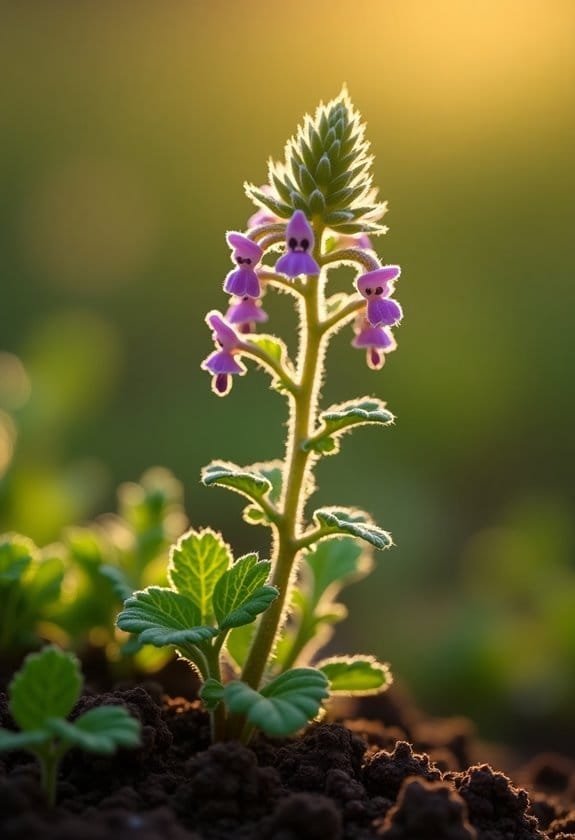Henbit deadnettle (Lamium amplexicaule) is a resilient annual herb in the mint family that reaches heights of 10-25 cm. It's characterized by square stems shifting from reddish-green to purple, rounded stem-clasping leaves measuring 2-3 cm, and distinctive pink-purple tubular flowers blooming in early spring. This adaptable plant thrives in temperatures between 10-20°C and serves as an essential nectar source for early-emerging pollinators, particularly honeybees and bumblebees. While some gardeners consider it a weed, henbit's edible nature and ecological importance in supporting biodiversity make it worthy of deeper consideration beyond its humble appearance.
Main Points
- Henbit Deadnettle is an annual plant in the mint family with square stems, rounded leaves, and pink-purple tubular flowers.
- Growing 10-25 cm tall, it thrives in cool, moist environments and can adapt to both full sun and partial shade.
- The plant serves as a vital early-spring nectar source for bees and pollinators, supporting local ecosystem biodiversity.
- All parts are edible with a mild, peppery flavor, though it's often considered a weed due to its aggressive spreading nature.
- It employs both open and self-pollinating flowers, ensuring reproduction while creating persistent seed banks that remain viable for years.
Introduction

Henbit Deadnettle (Lamium amplexicaule), a member of the mint family Lamiaceae, has established itself across the United States after arriving from its native regions in Europe, western Asia, and northern Africa.
This adaptable winter annual showcases distinctive heart-shaped leaves with scalloped margins and produces clusters of pink to purple tubular flowers that emerge in early spring.
Though often classified as a common garden weed, Henbit serves a vital ecological role by providing essential nectar and pollen resources for early-season pollinators when few other flowering plants are available.
Common Name
A gardener's familiarity with Lamium amplexicaule often begins with its common name, Henbit Deadnettle, or simply Henbit. This distinctive name has a practical origin, derived from the plant's historical significance as a favored food source for domesticated chickens, or hens, which would enthusiastically forage on its tender leaves and stems.
While Henbit serves as the plant's primary common name throughout North America, it's also known by variations such as Greater Henbit and Common Henbit in different regions.
The "deadnettle" portion of its name refers to its membership in the mint family (Lamiaceae) and its superficial resemblance to stinging nettles, though it lacks the characteristic stinging properties of true nettles.
Early European settlers introduced this plant to North America, where its common name traveled with it and became firmly established in the botanical lexicon.
Curiously, the plant is frequently mistaken for its close relative, Purple Deadnettle (Lamium purpureum), leading to occasional confusion among gardeners and botanists who must learn to distinguish between these similar species despite their shared common name heritage.
Scientific Name
Since its formal classification in 1753, the scientific name Lamium amplexicaule has identified this common garden plant worldwide. This binomial nomenclature, established by the renowned botanist Carl Linnaeus, perfectly captures the plant's distinctive characteristics and taxonomic placement within the Lamiaceae family.
The genus name "Lamium" draws its origins from the Greek language, specifically referencing the word meaning "to lick," which alludes to the plant's historical uses and unique properties.
Meanwhile, the species epithet "amplexicaule" provides a vivid description of one of the plant's most distinguishing features: its stem-clasping leaves, as the Latin term literally translates to "stem-clinging."
Henbit Deadnettle's scientific classification within the mint family (Lamiaceae) reflects its relationship to other aromatic herbs and plants sharing similar characteristics.
This taxonomic placement helps botanists and gardeners understand its growth patterns, potential uses, and management strategies, while its precise scientific name guarantees consistent identification across different regions and languages where the plant is found.
Overview
Beyond its formal scientific classification, this versatile member of the mint family has earned recognition as both a common garden companion and occasional nuisance throughout North America. Its distinctive square stems, which often develop a purple hue with maturity, support an array of rounded to heart-shaped leaves featuring delicately scalloped margins measuring 2-3 cm across.
In early spring, Henbit transforms landscapes with its charming display of pink to purple blooms, each measuring ½-¾ inch in length and arranged in symmetrical whorls along the stem. As an early-season source of nectar, these flowers prove invaluable to awakening pollinators, particularly honeybees emerging from winter dormancy.
The plant's remarkable survival strategy includes producing seeds that can remain viable in soil for up to five years, enabling it to establish persistent populations in various environments.
While some gardeners view Henbit's spreading tendency with concern, its ecological contributions can't be overlooked. This adaptable plant has successfully colonized open areas, gardens, and disturbed sites, where it serves as an important bridge species during the changeover period between winter and spring.
Key Features
Henbit deadnettle stands as a modest annual plant, reaching typical heights between 10-25 centimeters, though exceptional specimens can stretch to 40 centimeters.
Its distinctive appearance comes from square stems that shift from reddish-green to purple with age, complemented by rounded leaves measuring 2-3 centimeters in diameter.
The plant bursts into bloom during early spring, producing vibrant pink to purple flowers spanning 1.5-2 centimeters in length, which cluster in terminal spikes and feature both open and self-pollinating cleistogamous flowers.
Growth Size
As a member of the mint family, the deadnettle grows to a modest height of 10-25 cm (4-10 inches), though it can reach up to 40 cm (16 inches) in ideal conditions. This growth size positions henbit as a low-growing herbaceous plant that often forms dense mats across the ground, particularly in disturbed areas.
The plant's growth pattern is characterized by its square stems, which develop a distinctive reddish-purple hue as they mature and extend upward. Along these stems, opposite pairs of rounded leaves emerge, each measuring 2-3 cm in diameter, creating a balanced and symmetrical appearance.
The tubular flowers, measuring 1.5-2 cm in length, emerge in whorled clusters that encircle the stem at regular intervals.
What makes henbit's growth size particularly interesting is its ability to root at lower stem nodes, a characteristic that enables effective horizontal spread. This adaptive growth strategy allows the plant to establish itself firmly while maintaining its relatively modest vertical height, making it both resilient and successful in colonizing various environments where it can maintain its characteristic growth dimensions.
Appearance
This distinctive member of the mint family showcases several key identifying features, starting with its square, reddish-colored stems that can root at lower nodes. These stems, which occasionally transform to a green hue, serve as the plant's primary support structure and contribute to its spreading growth pattern.
The plant's foliage presents a particularly striking arrangement, with leaves growing in opposite pairs along the stem. These leaves exhibit a characteristic rounded to kidney-shaped form, measuring 2-3 cm in diameter, and feature distinctly scalloped margins that create an ornate appearance.
Perhaps most importantly, the upper leaves demonstrate an amplexicaul growth pattern, meaning they wrap directly around the stem without stalks.
Adding to its visual appeal, Henbit Deadnettle produces delicate pink to purple blossoms measuring 1.5-2 cm in length. These flowers emerge in terminal spikes complemented by axillary whorls, creating an eye-catching display that distinguishes it from similar species.
The plant's overall structure typically reaches heights between 10-25 cm, though particularly robust specimens may stretch up to 40 cm tall.
Flowering Season
When winter's grip begins to loosen, these resilient plants burst into bloom, typically flowering for one to two months during spring. In warmer regions, henbit deadnettle's flowering season can commence as early as February, producing delicate pink to purple blossoms that measure between ½ to ¾ inch in length.
The plant's flowering structure consists of axillary and terminal inflorescences, each hosting 6-12 sessile flowers arranged in characteristic whorls around the stem.
While spring remains the primary blooming period, some specimens demonstrate remarkable adaptability by producing sporadic flowers during autumn months, effectively extending their reproductive window.
This early flowering season plays a crucial ecological role, providing necessary nectar and pollen resources for emerging pollinators, particularly honeybees and bumblebees.
The plant's reproductive success is further enhanced by its ability to self-pollinate through cleistogamous flowers, specialized blooms that remain closed and self-fertilize. This adaptation guarantees successful reproduction even when external pollination opportunities are limited, contributing to the species' widespread distribution and resilience in various environments.
Growing Requirements

Henbit deadnettle thrives in full sun to partial shade conditions, where it can establish strong root systems in various soil compositions.
Its adaptable nature allows it to flourish in cool, moist environments with temperatures typical of early spring and late fall, making it particularly successful as a winter annual in temperate regions.
While this plant demonstrates remarkable resilience across different growing conditions, it shows ideal development in well-draining soils with consistent moisture levels and temperatures ranging between 10-20°C (50-68°F).
Light
A versatile grower regarding light requirements, the henbit deadnettle adapts well to both partial shade and full sun environments. This remarkable adaptability enables the plant to colonize various habitats, from garden edges to open fields, where light conditions might fluctuate throughout the day.
The plant's growth cycle demonstrates its strategic use of available light resources, with germination typically occurring in fall and vigorous growth resuming in early spring. During these cooler seasons, henbit capitalizes on increased light penetration through deciduous canopies before other vegetation fully develops.
While the plant tolerates shaded conditions, it exhibits ideal growth and flowering when exposed to direct sunlight, particularly in disturbed or unmanaged areas where competition for light is minimal.
In urban and cultivated settings, henbit's light tolerance allows it to thrive in locations where other plants might struggle, such as along roadsides or in partially shaded garden beds. This adaptation to varied light conditions contributes to its success as a widespread plant, with spring flowering coinciding with periods of increased daylight intensity.
Soil
Most gardeners encounter henbit deadnettle in cool, moist soil conditions where it thrives as an opportunistic grower. This adaptable plant demonstrates remarkable persistence in disturbed areas, particularly where regular soil management practices are absent, such as along roadsides and in neglected lawns.
The plant's relationship with soil is complex and multifaceted, showing a distinct preference for pH levels between 6.0 and 7.0. While henbit favors nutrient-rich environments, it's remarkably versatile and can establish itself in various soil types, often taking advantage of weak or sparse turf areas where grass struggles to maintain dominance.
Its seeds can remain dormant yet viable in the soil for up to five years, creating a persistent seed bank that enables repeated colonization when conditions become favorable.
Effective soil management plays an essential role in preventing henbit infestations. The implementation of proper drainage systems and regular fertilization programs can greatly reduce the plant's ability to establish itself, as healthy, well-maintained soils typically support robust desirable vegetation that naturally suppresses henbit's opportunistic growth patterns.
Water
Beyond soil conditions, water requirements play a key role in henbit deadnettle's success. The plant demonstrates a marked preference for environments with consistent moisture levels and moderate rainfall, which directly influences its growth patterns and distribution. During its primary germination period in fall, henbit capitalizes on cooler temperatures and seasonal precipitation to establish robust root systems.
While henbit exhibits remarkable adaptability to varying moisture conditions, it performs best in well-hydrated environments that maintain consistent soil moisture without becoming waterlogged. The plant's specialized ability to root at lower nodes serves as a survival mechanism, enabling it to access water resources even when surface moisture becomes limited.
During extended dry periods, henbit may show signs of stress, though its resilient nature often allows it to persist through temporary drought conditions. In situations where natural rainfall proves insufficient, supplemental irrigation can greatly enhance the plant's vigor and overall performance.
This adaptability to different moisture levels, combined with its preference for cool, damp conditions, explains why henbit frequently establishes itself in regions characterized by moderate precipitation patterns.
Temperature
Temperature tolerance plays an essential role in henbit deadnettle's growth cycle, with the plant showing remarkable adaptability to cool conditions. This hardy species demonstrates impressive resilience by continuing its growth even when temperatures drop to 20°F (-6°C), making it a successful winter annual in many regions.
For ideal growth and development, henbit thrives when soil temperatures maintain a range between 60°F and 70°F (15°C to 21°C), creating perfect conditions for seed germination and establishment.
The plant's preference for cooler temperatures explains its proliferation during early spring and fall seasons, when moderate climate conditions support its vigorous growth patterns. In regions with milder winters, henbit takes advantage of late winter warmth to initiate flowering, while populations in cooler climates delay blooming until late spring arrives.
This temperature-driven flowering schedule perfectly illustrates the plant's ability to adapt its lifecycle to local climate conditions. While henbit can endure considerable cold, it maintains peak performance in environments that offer cool to moderate temperatures, especially when combined with appropriate light exposure, whether in full sun or partial shade.
Pollinator Criteria
Henbit's vibrant pink-to-purple flowers serve as an important early-season nectar source for honeybees, bumblebees, and hummingbirds when other flowering plants remain dormant.
The plant's reproductive strategy combines both open flowers for cross-pollination by these visitors and cleistogamous flowers that enable self-pollination, ensuring successful reproduction across various environmental conditions.
This dual pollination approach, coupled with Henbit's extended spring blooming period of one to two months, makes it an essential contributor to pollinator survival and local ecosystem health.
Attracted Pollinators
Through its early spring blooms, Henbit Deadnettle serves as an important food source for essential pollinators when other flowering plants are scarce. The pollen plant's distinctive pink to purple flowers, measuring ½-¾ inch in length, attract a diverse array of beneficial insects seeking sustenance during the early growing season.
Honeybees and bumblebees are particularly drawn to Henbit's tubular, bilabiate flowers, which have evolved specifically to accommodate these industrious pollinators. The plant's ability to produce both open and cleistogamous flowers guarantees successful reproduction while supporting pollinator populations, even in challenging environmental conditions.
This adaptive strategy maintains a steady flow of nectar and pollen resources for visiting insects.
When Henbit grows in dense patches, its vibrant floral displays create beacon-like signals that draw pollinators from considerable distances. These concentrated nectar sources serve as vital refueling stations for early-emerging bees and other insects, contributing greatly to local biodiversity.
The plant's role in supporting various insect species makes it an integral component of healthy ecosystem dynamics, particularly during the essential early spring period.
Pollination Method
Adapted for successful reproduction, Henbit Deadnettle employs a dual pollination strategy through its distinct flower types. The plant produces both open, showy flowers and cleistogamous flowers, guaranteeing reproductive success under varying environmental conditions.
The open flowers, with their distinctive tubular, bilabiate structure, serve as beacons for cross-pollination through insect activity. These pink to purple blooms are strategically arranged in clusters of 6-12 flowers, creating prominent displays that attract honeybees and bumblebees during early spring foraging.
The timing of the bloom period, lasting up to two months, synchronizes perfectly with the active seasons of these essential pollinators.
Meanwhile, the cleistogamous flowers act as a reproductive insurance policy, capable of self-pollination without requiring insect visitors. This dual approach maximizes the plant's reproductive potential, as pollen transfer can occur even when pollinator activity is limited by adverse weather conditions.
The combination of both pollination methods, coupled with the extended flowering period, demonstrates Henbit's evolutionary adaptation to guarantee consistent seed production and species survival.
Care & Maintenance

Successful henbit control requires an integrated approach that emphasizes proper lawn maintenance and regular monitoring of vulnerable areas.
Gardeners should maintain dense turf through consistent mowing patterns and balanced fertilization schedules, while adapting grass species that thrive in shaded regions where henbit typically establishes itself.
Strategic companion planting with vigorous ground covers and prompt removal of rooting stem pieces can notably reduce henbit's ability to spread through gardens and open spaces.
Planting Tips
Growing henbit deadnettle successfully requires attention to its preferred environmental conditions.
Ongoing Care
The ongoing care of henbit deadnettle focuses on preventing its spread throughout gardens and lawns. Regular monitoring during early spring, when the plant produces its upper flowers rich in nectar, allows gardeners to implement timely control measures before extensive colonization occurs.
Maintaining a vigorous lawn through proper cultural practices serves as the first line of defense against henbit invasion. Strategic mowing, particularly before the plant can set seed, disrupts its reproductive cycle and helps minimize future infestations.
When managing established patches, it's essential to remove all stem fragments from moist soil, as these pieces can readily root and establish new colonies.
An integrated approach to henbit management combines multiple control strategies for the best results. This includes regular hand-pulling of isolated plants, maintaining appropriate fertilization schedules to promote competitive grass growth, and applying selective herbicides when necessary.
Suggested Companions
When planning companion plantings around henbit deadnettle, gardeners should focus on species that can establish strong root systems and compete effectively for resources. Clover and low-growing grasses make excellent companion plants, as they create dense turf systems that help maintain soil stability while coexisting with henbit's spreading nature.
Cool-season vegetables like spinach and kale prove particularly compatible, sharing henbit's preferences for moisture levels and growing conditions during the earlier parts of the growing season.
Native wildflowers enhance the garden's biodiversity while providing additional nectar sources for beneficial insects, creating a more robust ecosystem where henbit can thrive without becoming overwhelming.
To maintain a balanced relationship between henbit and its companion plants, implementing strategic mowing practices becomes crucial. Regular cutting, especially before seed formation, helps control henbit's spread while allowing companion plants to establish themselves.
This integrated approach to plant management guarantees that henbit deadnettle contributes positively to the garden ecosystem while remaining in check through natural competition and thoughtful maintenance practices.
Are Wild Candytuft and Henbit Deadnettle Found in Similar Habitats?
Wild candytuft and henbit deadnettle often thrive in overlapping habitats, such as meadows and open fields. Wild candytuft iberis amara plant characteristics include tolerance for rocky soils and sunny locations, making it well-suited to disturbed areas where henbit deadnettle also grows. Both plants contribute to vibrant, natural landscapes with unique ecological roles.
Common Issues
Henbit Deadnettle's primary challenges stem from its aggressive colonization patterns, which can quickly overtake weakened lawn areas and create persistent management issues.
While this plant typically doesn't suffer from major pest or disease problems, its resilient nature and ability to root from stem fragments make traditional control methods less effective.
Successful management requires an integrated approach combining consistent mowing practices, proper soil fertility maintenance, and careful monitoring of potential spread zones, particularly in areas with compromised turf density.
Pests/Diseases
Most gardeners find henbit deadnettle to be naturally hardy against pests and diseases, though it can face several common issues.
Primary among these concerns are aphids, which can colonize the plant's tender stems and leaves, potentially leading to stunted growth and weakened overall health. Spider mites may also become problematic, particularly in dense populations where they can spread to neighboring vegetation.
In humid conditions, henbit becomes susceptible to fungal infections, with powdery mildew being a notable threat that manifests as a white, powdery coating on the foliage.
The plant's tendency to thrive in disturbed areas can make it particularly vulnerable to root rot, especially in poorly draining soils where excess moisture accumulates around its root system. This condition often develops when the plant's growing environment lacks proper ventilation or becomes overcrowded with neighboring vegetation.
To combat these issues effectively, implementing an integrated pest management approach proves beneficial.
This strategy includes regular monitoring for early signs of infestation, maintaining appropriate spacing between plants, and ensuring ideal growing conditions through proper soil drainage and air circulation.
Solutions
Several effective solutions exist for managing common henbit issues in gardens and lawns. The most fundamental approach involves maintaining dense turf through consistent mowing and proper fertilization, which creates robust competition against this persistent weed.
Adapting grass species in shaded locations proves particularly beneficial, as it helps establish a strong vegetative barrier that naturally suppresses henbit's ability to colonize these areas.
For ideal control, integrated weed management practices combine multiple strategies to address henbit infestations thoroughly. Regular monitoring of garden spaces allows for early detection and removal of stem pieces before they can establish roots in moist soil conditions.
Since henbit seeds can remain dormant for up to five years, vigilant observation becomes vital for long-term management success. A systematic approach that incorporates cultural methods, such as proper lawn maintenance, alongside mechanical removal techniques provides the most effective defense against henbit establishment.
When implemented consistently, these solutions create an environment where desirable plants can thrive while naturally suppressing henbit's ability to compete for resources and space.
Summary

The versatile Lamium amplexicaule, commonly known as henbit deadnettle, is a cool-season annual plant from the mint family that offers both ecological and culinary benefits.
This adaptable species emerges in fall or early spring, displaying distinctive square stems and rounded leaves that complement its pink to purple tubular blooms.
As an important early spring nectar source, henbit plays an essential role in supporting pollinator populations, particularly benefiting honeybees when few other flowering plants are available.
Its seeds can remain dormant in the soil for up to five years, ensuring sustained presence in various environments from manicured lawns to open fields.
While some gardeners consider it a weed, henbit's multiple attributes challenge this classification.
The plant's edibility adds to its appeal, offering a mild, peppery flavor profile that enriches salads and herbal teas while providing essential nutrients.
Beyond its culinary applications, henbit's contribution to biodiversity and sustainable gardening practices demonstrates how seemingly humble plants can serve valuable ecological functions, encouraging a more nuanced approach to landscape management.


